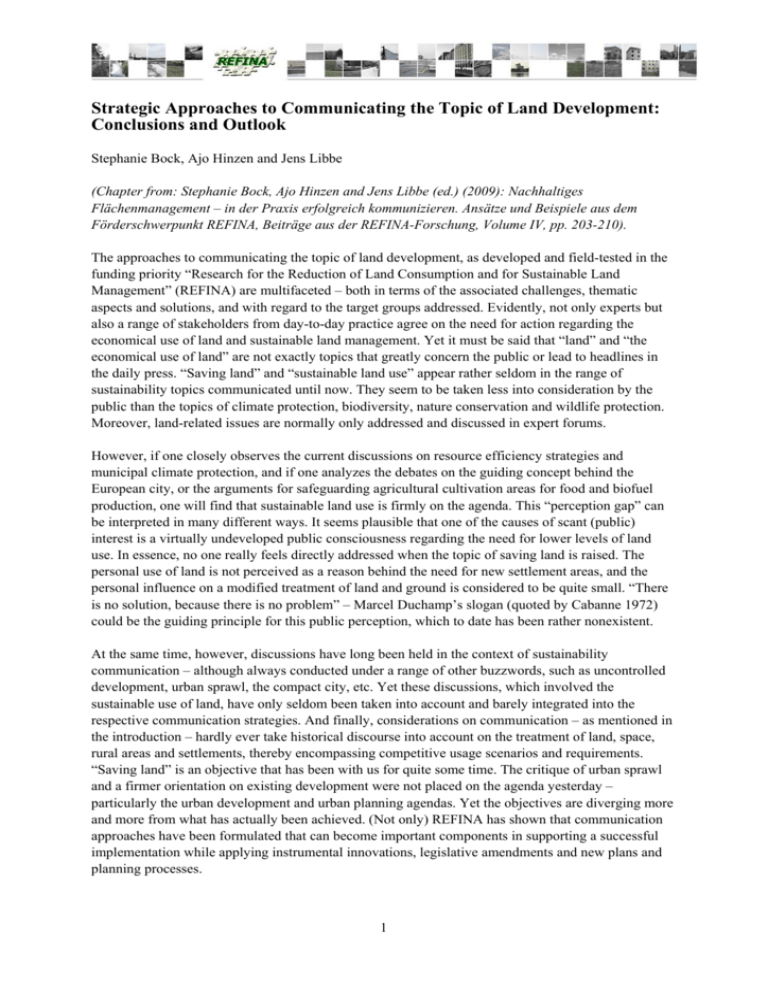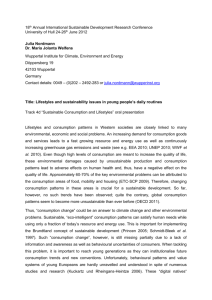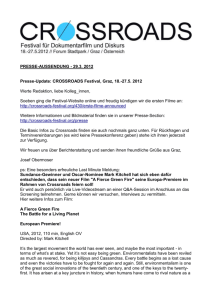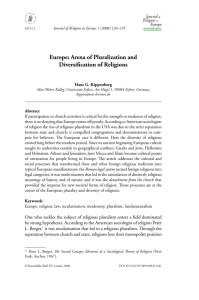Strategic Approaches to Communicating the Topic of Land
advertisement

1 Strategic Approaches to Communicating the Topic of Land Development: Conclusions and Outlook Stephanie Bock, Ajo Hinzen and Jens Libbe (Chapter from: Stephanie Bock, Ajo Hinzen and Jens Libbe (ed.) (2009): Nachhaltiges Flächenmanagement – in der Praxis erfolgreich kommunizieren. Ansätze und Beispiele aus dem Förderschwerpunkt REFINA, Beiträge aus der REFINA-Forschung, Volume IV, pp. 203-210). The approaches to communicating the topic of land development, as developed and field-tested in the funding priority “Research for the Reduction of Land Consumption and for Sustainable Land Management” (REFINA) are multifaceted – both in terms of the associated challenges, thematic aspects and solutions, and with regard to the target groups addressed. Evidently, not only experts but also a range of stakeholders from day-to-day practice agree on the need for action regarding the economical use of land and sustainable land management. Yet it must be said that “land” and “the economical use of land” are not exactly topics that greatly concern the public or lead to headlines in the daily press. “Saving land” and “sustainable land use” appear rather seldom in the range of sustainability topics communicated until now. They seem to be taken less into consideration by the public than the topics of climate protection, biodiversity, nature conservation and wildlife protection. Moreover, land-related issues are normally only addressed and discussed in expert forums. However, if one closely observes the current discussions on resource efficiency strategies and municipal climate protection, and if one analyzes the debates on the guiding concept behind the European city, or the arguments for safeguarding agricultural cultivation areas for food and biofuel production, one will find that sustainable land use is firmly on the agenda. This “perception gap” can be interpreted in many different ways. It seems plausible that one of the causes of scant (public) interest is a virtually undeveloped public consciousness regarding the need for lower levels of land use. In essence, no one really feels directly addressed when the topic of saving land is raised. The personal use of land is not perceived as a reason behind the need for new settlement areas, and the personal influence on a modified treatment of land and ground is considered to be quite small. “There is no solution, because there is no problem” – Marcel Duchamp’s slogan (quoted by Cabanne 1972) could be the guiding principle for this public perception, which to date has been rather nonexistent. At the same time, however, discussions have long been held in the context of sustainability communication – although always conducted under a range of other buzzwords, such as uncontrolled development, urban sprawl, the compact city, etc. Yet these discussions, which involved the sustainable use of land, have only seldom been taken into account and barely integrated into the respective communication strategies. And finally, considerations on communication – as mentioned in the introduction – hardly ever take historical discourse into account on the treatment of land, space, rural areas and settlements, thereby encompassing competitive usage scenarios and requirements. “Saving land” is an objective that has been with us for quite some time. The critique of urban sprawl and a firmer orientation on existing development were not placed on the agenda yesterday – particularly the urban development and urban planning agendas. Yet the objectives are diverging more and more from what has actually been achieved. (Not only) REFINA has shown that communication approaches have been formulated that can become important components in supporting a successful implementation while applying instrumental innovations, legislative amendments and new plans and planning processes. 1 2 The analyses and reflections conducted in the funding priority REFINA on communication models for sustainable land management that have been more or less implemented to date show one thing without a doubt: Until now, the challenge of communication and awareness-raising for sustainable settlement development has normally been met with either insufficient or incomplete concepts. Given limited resources, such concepts try to provide the greatest possible range of information on this complex topic to as many of the potential target groups as possible. The strategy here is to communicate everything at once and as comprehensively as possible, and ideally also the most difficult factors first. However, the focus of these communication approaches is not on potential supporters, but rather those groups who exert major resistance. Additionally, there is an expectation of convincing these groups of what is “better”. In workshops conducted as related research on the funding priority REFINA, it has been confirmed that communication on sustainable land management is generally too complex with regard to the transported messages. Too many and overly heterogeneous messages are conveyed simultaneously to those players that still need to be convinced. Above all, this approach lacks appropriate conceptual models for “reaching out to” the addressees in the world in which they live. A preliminary conclusion: Communication on the topic of saving land is still in its infancy. The professionalization of the communication approach is, evidently, an absolute necessity. The approaches covered in this report show clearly that the wheel does not have to be reinvented. Important aspects can be adopted from the communication sciences, and also, pragmatically, from public relations work that benefits sustainable products. Evidently, the classic advertising strategy that aims for the permanent penetration of a message in the public consciousness has not yet worked for sustainable topics. It would be more effective here to build on the target groups’ interest in key topics, such as the careful use of resources. The REFINA results as presented clarify the value of a positive message, which must be linked to sustainable land management. “Communication must motivate behaviour which does not demand that people renounce things, but which instead is linked to positive feelings such as fun, diverse experiences and gratification of the senses” (Kuckartz/Schack 2002, p. 92). Thus the key messages to be conveyed are not cost-cutting and prevention, but rather conservation and strengths; not consumption and reduction, but rather improved quality of life. “Knowledge alone, particularly abstract knowledge which is less action-based, and which is often compiled through surveys on environmental awareness, does not necessarily guarantee environmentally friendly practices. Nevertheless, it can be defined as one of several necessary conditions” (Kruse 2007, p. 117). Even if the gap between environmental awareness and environmental actions is not easy to overcome, and no automatic link between environmental knowledge and respective actions can be magically established with the “cure-all solution” of communication, the primary communication target should not be the definition of a 30-hectare goal, but rather changing behaviour. Even if, in one form or another, land is important to the everyday lives of most people – or indeed maybe for the very reason that its use is taken for granted – many people do not feel as if they themselves have been addressed as far as the sustainable use of land is concerned, and do not necessarily recognize opportunities for action. Therefore, the strategy can and should not be merely to implement a broad-based public campaign. It has become increasingly clear, in as far as the topic of land management is concerned, that more than one target group that can affect and oversee land use should be addressed. “To attain the 30-hectare goal, neither one ‘singular’ quota imposed by the state ‘by decree’, nor a circulation mechanism planned with military precision on the allowable area growth is sensible or conceivable. Rather, the responsibility for land utilization lies with a diverse range of sovereign and social stakeholders from the business world and from cities and municipalities, along with architects and urban planners, representatives from the traffic sector and other fields which affect land utilization, as well as banks and property owners, and last but certainly not least with the landowners themselves” (RNE 2004, p. 26). If one would like to systematically reach the relevant 2 3 target groups affecting and modifying land utilization, then the responsible players must be identified, primarily on the local and regional level of land-related decisions (including those decisions that affect our general welfare, such as on cultural/environmental conservation, the landscape, local recreation, CO2 reduction, etc.). Alternatively, those private households which are currently about to build a home that has the potential to alter the immediate environmental landscape must be targeted and addressed. Both land and land utilization are organized and influenced by numerous players with very different interests. The respective communication strategies should therefore address these highly diverse groups in a targeted manner. Regardless of whether from citizens of different social milieus, owners of smaller properties, building owners or companies with their “land policies”, all pursue highly specific interests and must therefore be addressed and/or motivated in the respective manner. The forms of target group communication developed in REFINA show how it is possible to provide relevant information with the help of documents and tailored communication strategies, thus illustrating different approaches to action. A high level of competence and credibility on the part of the communicator has proven to be extremely important in this process, along with precise, easily understandable, personalized and lively information materials, which build on the existing convictions, interests and knowledge of the respective target groups. Successful points of contact for communicating what at first may be perceived as an abstract topic are the following aspects: “follow-up costs”, “efficiency” and “attractiveness of the subsequent use”. This has been shown by the REFINA results. Quality aspects, i.e. preserving the cultural landscape on the outskirts of the city, or the creation of a high-quality living and residential environment on re-used land, represent important arguments for certain target groups (in addition to “gut decisions”). Economic reasons facilitate the acceptance of specific arguments for saving land while also promoting an active implementation. The “economic persuasion approaches”, as presented in this volume, are directed at private households that face individual decisions affecting a new residential neighbourhood. The economic factor is just as important for municipal target groups. With the goal of creating cost transparency in settlement development within the residential and commercial sectors, various tools and models have been developed in the REFINA funding programme for the cost-benefit analysis (as well as evaluating the follow-up costs) (cf. Preuß/Floeting 2009). Cost transparency is designed to facilitate the consideration of various planning alternatives and lead to a larger degree of sustainability. In this context, cost-effective planning approaches can often simultaneously be approaches that minimize land use. Planning of this sort exploits previously developed building areas and contributes to the more efficient use of existing infrastructures – particularly with regard to future demographic development. It reduces residual overhead costs (costs that are not immediately eliminated even though the infrastructure is not currently being used, or infrastructure use has ceased altogether) and limits the extent of new infrastructure outlay. In addition to this necessary differentiation of communication arguments for various target groups, the municipalities are an important – though not the most important – contact and communication partner in the area of sustainable land management. It is the municipalities that primarily make decisions concerning short- and long-term land use. The implementation of sustainability at the municipal level already has a long history. The most well-known issue in this respect is certainly the Agenda 21 action plan, which as a blueprint for local action was taken seriously by many municipalities, turning them into the main theatres of sustainability discourse in Germany. But also in the context of other political fields (urban development, environmental protection, demography, etc.), it is primarily the long-term aspects of sustainable development that have moved into the foreground in connection with an integrated viewpoint. A discrepancy can frequently be recognized in local government policies between findings and value systems on the one side and emotional, clientele-oriented decisions on the other side. This discrepancy must be overcome. Only when it is possible for political players to present the careful use of land resources and “land saving” aspects as an unmitigated success and also 3 4 communicate these to the public will communication on sustainability have reached an important milestone. Scenarios can greatly contribute to the strategic discourse on sustainability and future issues – something that has also been tested within the REFINA framework. When using communicative scenarios designed to initiate a dialogue between different players, creating sensitivity for the various future paths is of key importance, as well as identifying corridors of power and communicating a vision for the future. In this context, scenarios can be a means of recognizing, running through and mediating possible long-term developments. They show “possible futures”, without making statements as to whether these are probable (forecasts) or desirable (imperatives). In the context of discussions concerning the land use management-related 30-hectare goal, they have been employed in REFINA as both fresh impetus and talking points. Essentially, strategic communication also encompasses approaches toward sustainable knowledge transfer on scientific findings compiled within the REFINA framework. If one considers the increasingly changing relationship between science and the public and accepts that more and more, the scientific sector will be forced to open up and reconsider its public relations tactics, this will result in far-reaching consequences for both the communication of results and the shaping of communicative processes over the course of scientific projects. The opportunities, but also the limits of knowledge transfer between science and the public must be focused on more strongly. It is by no means a coincidence that knowledge production conforms to a transdisciplinary model in the context of sustainability research. The integrative organization of research thus promoted has a two-fold importance. First of all, collective problem-solving, which develops out of its transdisciplinary nature, requires a communicative process of exchange with players from the social practice. Additionally, “sustainability communication is given the role of disclosing knowledge gained in inter- and transdisciplinary research processes, as well as bringing the respective perception of problems related to questions of sustainable development into the public discourse” (Godemann 2007, p. 87). The experiences compiled to date show that difficulties could arise, and for various reasons. Frequently, a common language is lacking; sometimes, disciplinary expertise cannot be made understandable; and problems in understanding– or even outright misunderstandings – may arise. The prerequisite for successful transdisciplinarity is communication on the fact that all parties involved must not only communicate with one another, but must also come up with a common knowledge basis. Communication processes are a mandatory component of collaboration. In this respect, they require, among other factors, the transfer or results through the use of an innovative, practice-oriented training concept. The communication approaches, as developed in REFINA, continue the promising initiatives and activities related to communication on the topic of land management that have been developed in other areas. Useful points of contact here include the travelling exhibition “Wie wohnen, Wo leben? Flächen sparen – Qualität gewinnen!” (“How and Where to Live? Saving Land – Gaining Quality!”) by the Bavarian Environment Agency, the exhibition “Flächen gewinnen” (“Gaining Land”) by the Ministry of the Environment in Baden-Württemberg, the film “Ende im Gelände” (“End of the Country”) by the Environmental Protection Association of Baden-Württemberg and the Internet platform “Nachbar Natur” (“Neighbouring Nature”) from the German Environment Conservation Agency (NABU), connected with the public campaign “Living 2010: Flächensparen – Natur erhalten” (“Living 2010: Conserving Land – Preserving Nature”). One thing that all these channels have in common is the fact that they try to sensitize new target groups to the issue in an entertaining and appealing way. In his concluding address on communication at the third REFINA Status Seminar, Klaus Selle sent the REFINA staff and the specialist public on their way with important new ideas. In so doing, the 4 5 configuration of communication approaches as developed in REFINA could also be brought to a conclusion (cf. Selle 2009). In posing the question “Do we merely have to sell it correctly?” he opened up new perspectives on communicating the topic of land. Understanding communication as a process of understanding – and thereby giving serious consideration to the communication of sustainability and sustainable land management as a specific process of understanding – means first and foremost gaining greater awareness for existing roles and their importance within these processes. Furthermore, it means being able to realistically assess the various latitudes for action as well as the ways in which influence can be exerted. In practice, however, clashes in different rationales and sets of logic are unavoidable, even if these viewpoints would seem correct when considered separately. In this way, communication always presupposes that all parties involved have a firm interest in the common process of understanding – and, at the same time, are prepared to recognize its limits. In the context of REFINA, important new ideas have been tested in this direction, which are sure to incite replication, enhancement and further development. Bibliography Cabanne, Pierre (1972): Dialogues with Marcel Duchamp, Cologne, p. 7. Godemann, Jasmin (2007): Verständigung als Basis inter- und transdisziplinärer Zusammenarbeit, in: Michelsen, Gerd, and Jasmin Godemann (ed.): Handbuch Nachhaltigkeitskommunikation. Grundlagen und Praxis, Munich, pp. 86–96. Kruse, Lenelis (2007): Nachhaltigkeitskommunikation und mehr: die Perspektive der Psychologie, in: Michelsen, Gerd, and Jasmin Godemann (ed.): Handbuch Nachhaltigkeitskommunikation. Grundlagen und Praxis, Munich, pp. 111–122. Kuckartz, Udo, and Korinna Schack (2002): Umweltkommunikation gestalten, Opladen. Preuß, Thomas, and Holger Floeting (2009): Folgekosten der Siedlungsentwicklung. Bewertungsansätze, Modelle und Werkzeuge der Kosten-Nutzen-Betrachtung, Berlin (Studies from REFINA research, REFINA Series, Volume III). RNE (Rat für Nachhaltige Entwicklung) (2004): Mehr Wert für die Fläche: Das “Ziel-30-ha” für die Nachhaltigkeit in Stadt und Land. Empfehlungen des Rates für nachhaltige Entwicklung an die Bundesregierung, Berlin (Texts No. 11/July 2004). Selle, Klaus (2009): “Müssen wir das nur richtig verkaufen?” Kommunikation und die Rolle der Fachleute: Relativierungen, Missverständnisse & Folgerungen, lecture held at the 3rd REFINA status seminar on 24 March 2009 in Berlin (http://www.refina-info.de/termine/2009-03-23selle.pdf). 5











